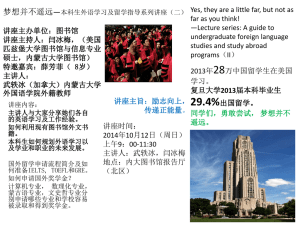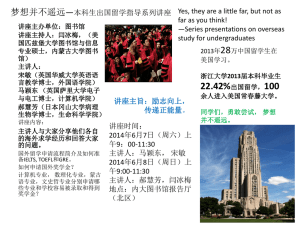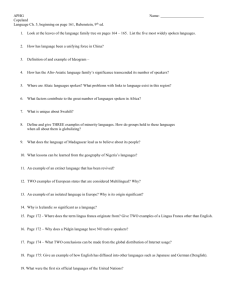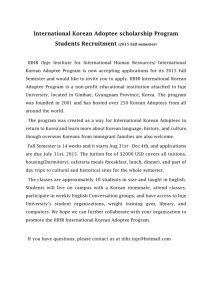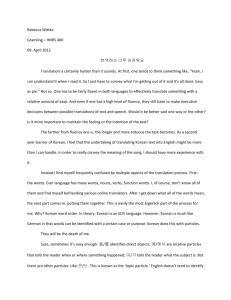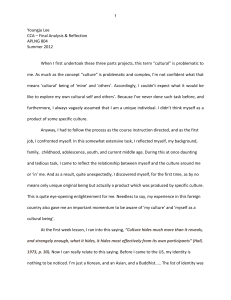Document 7780687
advertisement
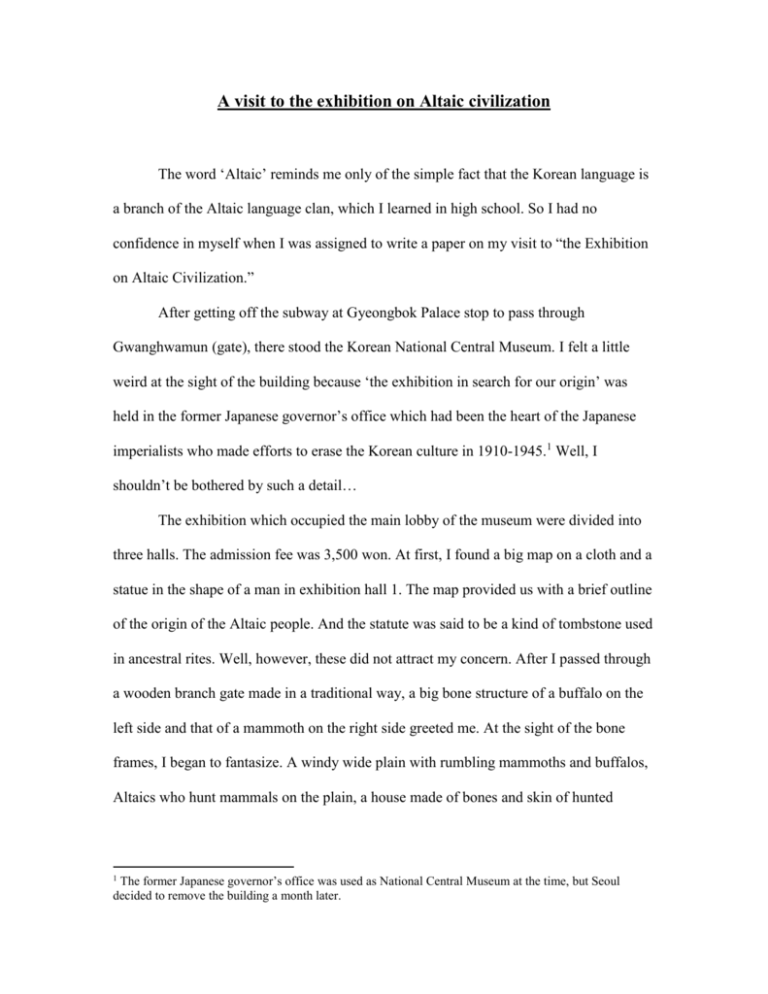
A visit to the exhibition on Altaic civilization The word ‘Altaic’ reminds me only of the simple fact that the Korean language is a branch of the Altaic language clan, which I learned in high school. So I had no confidence in myself when I was assigned to write a paper on my visit to “the Exhibition on Altaic Civilization.” After getting off the subway at Gyeongbok Palace stop to pass through Gwanghwamun (gate), there stood the Korean National Central Museum. I felt a little weird at the sight of the building because ‘the exhibition in search for our origin’ was held in the former Japanese governor’s office which had been the heart of the Japanese imperialists who made efforts to erase the Korean culture in 1910-1945.1 Well, I shouldn’t be bothered by such a detail… The exhibition which occupied the main lobby of the museum were divided into three halls. The admission fee was 3,500 won. At first, I found a big map on a cloth and a statue in the shape of a man in exhibition hall 1. The map provided us with a brief outline of the origin of the Altaic people. And the statute was said to be a kind of tombstone used in ancestral rites. Well, however, these did not attract my concern. After I passed through a wooden branch gate made in a traditional way, a big bone structure of a buffalo on the left side and that of a mammoth on the right side greeted me. At the sight of the bone frames, I began to fantasize. A windy wide plain with rumbling mammoths and buffalos, Altaics who hunt mammals on the plain, a house made of bones and skin of hunted The former Japanese governor’s office was used as National Central Museum at the time, but Seoul decided to remove the building a month later. 1 mammals… The life must be a more natural and romantic one than we have here right now. Is there any heritage in me? I don’t know. Following the bones were the remains of the Paleolithic, Neolithic and Bronze Age. Choppers, arrowheads, axes, spears, mirrors, swords and paintings on rocks… Though there were pieces of earthenware excavated in Korea next to these, I couldn’t find any similarity between the remains found in the Altaic area and the Korean peninsula. While the Korean pieces of pottery had pointed bottoms, the Altaic ones had flat bottoms. While the comb-patterns on the Korean pottery were short and straight, those on the Altaic pottery were long and bent. Moreover, there were rubbed copies of an Altaic painting on the rock and Korean painting found at the seashore of Ulju, the southern part of Korea, but I couldn’t find even a resemblance between the two. I thought: “It’s quite natural for human to leave paintings on the walls or caves regardless of the civilizations. I don’t think that the fact that both left paintings on the walls proves the connection between Altaics and Koreans.” Well, when I was caught in such a thought, an assistant moved on towards me. I might be seen as embarrassed to him. “Are you working on your paper, sir?” “Yes, I have an assignment from my class. But, I have no idea about whether the Korean and Altaic remains have a bit of similarity.” “Well, then ask me what you are wondering.” “Um… Sorry to say this. But I can’t even realize what I should ask you.” “OK. Then listen to me carefully… Let’s start with pottery. You can find combpattern on both, right? The pattern itself is very crucial. You won’t find the comb-pattern on other pottery from other civilizations. Though the pattern looks different, it is because the tools used in each area were different, not because the people were totally different from each other. You also find that the Korean pottery have pointed bottoms while the Altaic have flat ones. This is because of the difference in their circumstances. People lived nearby sea or a river usually made pointed-bottom earthenware to place on soft ground such as sand. On the other hand, the people who lived in the plain area made flatbottom earthenware because there was firm ground everywhere. You should find the similarities at the mouths of the jars. Don’t they look similar to each other?” After his words, the pottery looked all similar to me. I mean it. He continued. “Let’s go to the paintings on the rock. The paintings of both Koreans and Altaics have three features in common. First, they stressed male genitals. In the paintings from other civilizations, they usually employed female images such as breasts for wishes for productivity. But, these two paintings used male genitals instead. Second, two paintings have a lot of circles that imply the sun. You know, many agricultural people have some beliefs in the moon as shown in Mesopotamian civilization. The fact that the ancestors of the Koreans, who were also agricultural people, worshiped the sun implies that the Koreans might have had some relations to the Altaic people. Third, you can also find something in common in the picture of the animals. In both paintings, they depicted the animals through their bones. This means that the two people had hunting as their main business at that time. You can find only outlines of animals in ancient paintings on papyrus from Egypt. Because of these points, the Koreans and the Altaics might have had much in common long ago.” “Gee, thanks. Your explanation was excellent and it will be great help to my paper.” I expressed my gratitude to him and moved to hall 2. Hall 2 held the Altaic traditional relics in the 19th and early 20th century. The Altaic area was the birthplace of various cultures because the area was occupied by the Huns, Uiguhr, Yenisey, and Kyrgyz. Though shown in only a small model, Tailga, an architect used for soul worship, was huge enough to surprise me. Besides, there were also Altaic traditional costumes of the 19th century. I also found something in common with the Korean costumes from a shaman bell, women’s accessories look like Korean ribbon (Daeng-gi) and so on. There were, however, also a lot of different points. The Altaic costumes were mainly made of leather and they were reluctant to use primary colors, which was quite far from the Korean way of making clothes. I also asked another assistant there for help, but I didn’t get kind and detailed reply this time. I went into Hall 3, where the main exhibit “Ice Princess” was displayed. “Ice Princess” was a corpse of a female priest in a lump of ice found at the place named Pazirik. As she had been preserved in ice for a long time like a mummy, she even had nails and tattoos that were not spoiled at all. “Ice princess” was just covered in the private part with a black cloth. At the sight, I just felt her to be pitiful. I thought it is not courteous to display someone’s dead, naked body to public though “she” may have some scholastic value. Was I wrong? I don’t know. Next to her, there stood a manikin girl that represented the live “Ice Princess.” Her hair ornament was splendid. It had a big circle with a deer and a panther carved, and a tall hair support that legendary bird griffins were engraved on. It must be hard to walk around with the ornament on, but it sure had been a mark of high status. After Hall 3, I found a souvenir shop. It was the end of the exhibition. Well, I was fascinated at the exhibition. If I have something to do with the Altaic nomadic tribes, it means that I have a legacy of a progressive spirit. With the imagination to ride a horse in a wide plain, I went to ride subway in the center of the city named Seoul.
